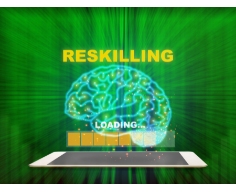2 min read
Developing Competencies for Virtual Classroom Facilitators
 Jennifer Hofmann
:
Jul 21, 2015 1:00:00 PM
Jennifer Hofmann
:
Jul 21, 2015 1:00:00 PM
 BYTE Session Recap
BYTE Session Recap
This blog post will highlight five key virtual facilitator competencies I discussed in a recent InSync BYTE session. At the end of the post, you will find some supplementary resources.
Competency #1: Digital Literacy
The InSync Training Virtual Facilitator Competency Model defines digital literacy as, "The ability to find, evaluate, utilize, share, and create content using information technologies and the internet."
When asked, participants shared that they learn about new technology in a variety of ways, including:
-
On LinkedIn
-
From their children and colleagues
-
By watching YouTube videos
An attendee also pointed out that, "Rapid typing speed is an important skill to be a fluid communicator via chat." And I completely agree! As I said during the session, "I do believe that rapid typing speed has become part of our digital literacy for anyone working in training now."
Competency #2: Virtual Classroom Fluency
Within the context of the competency model, virtual classroom fluency is defined as, "The ability to gauge the success of a virtual activity or conversation by reading digital cues and managing simultaneous conversations." One of the session participants provided a great synonym for this competency - "situational awareness." As he pointed out, "There is so much happening in the room and we have to pay attention to all of it."
Through chat, an attendee wisely pointed out that, "As a facilitator, having knowledge on the subject demonstrates fluency." I responded to that by saying, "I agree with that. [Virtual Classroom Fluency] not only [requires] that we have to know how to manage the technology, but we have to show expertise or show that we can facilitate."
Attendees voiced concerns about teaching virtual programs without producers. I shared my opinion that, “Without producers, we need to become even more fluent. I think as we are teaching more interactive and collaborative programs, and using tools like breakout rooms and application sharing, and really trying to do knowledge transfer and skill building, we need to become even more fluent.”
Competency #3: Cultural Intelligence
The most difficult competency to hire for is cultural intelligence or, “the ability to consider the audience and facilitate interactions that are inclusive and provide needed support for the culturally diverse global audience.”
While explaining the impact of cultural intelligence, the audience and I discussed common metaphors to avoid. One keenly observational attendee urged us to remember that, “Sports references don’t always work for other cultures,” and to “Watch time references because we are not always in the same time zone.”
Competency #4: Time Management
When considering the virtual program, time management is “the ability to manage a virtual event in such a way that participants are engaged and desired outcomes are met, and the event is kept to a strict time timetable.” While most of you know the importance of time management in every day life, there seems to an unawareness of its criticality for the virtual classroom facilitator.
I asked participants to share their virtual classroom time management techniques with the group to encourage attentiveness to this competency. Tactics discussed included:
-
Clock checks
-
Trainer guides
-
Using timers during breakout activities
-
Identify what you can pull in in advance (what’s important to know vs. what’s nice to know)
One attendee urged us to consider learner engagement when working on your time management skills. He said, “I think you should go no more than three minutes without giving them an activity or something new to look at. I bought an egg timer hourglass to remind me of this.” I commented that I really appreciated his suggestion "because our rule of thumb is that every three to five minutes participants should do something, [whether] it’s typing in chat or clicking a green checkmark.”
Competency #5: Application of Adult Learning Principles
Formally defined as “the ability to analyze a blended learning design to ensure the principles of adult learning are upheld and program objectives are met,” application of adult Learning principles is the last competency in our model.
Because learners decide what is important to them, virtual classroom facilitators must “engage learners, and get them emotionally connected to the content.” The big thing to remember is that adult learners are goal oriented. I pointed out that “if learners in blended and virtual programs don’t understand the purpose and outcome of the program, it’s easy for them to turn their attention elsewhere.”

Facilitation Tips Series, Part 1: Presence
In the recent rush to move so much training from face-to-face to the virtual setting, there’s a great deal of conversation about the technology:...

5 Core Strategies and Tactics for Effective Virtual Classroom Programs
Upskilling the “new normal” virtual world is no longer a “nice to have” but a matter of survival. Many facilitators learned the hard truth that...
